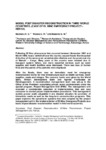Model Post Disaster Reconstruction in Third World Countries, (Case of El Nino Emergency Project– Kenya)
Abstract
Following El Nino phenomena that occurred between November 1997 and
March 1998, heavy rainfall all over the country caused floods that impacted
thirty-five of the seventy-six administrative districts and the provincial city
of Nairobi – Kenya. Many parts of the country were isolated due to
transport system failure, and many essential services such as water
supplies and health facilities were destroyed. There was loss of human
lives and thousands of households were displaced.
After the floods, there was an immediate need for emergency
reconstruction works for vital infrastructure such as health services, water
supplies, roads and bridges. The recovery funds were given by the World
Bank, African Development Bank and Agense Franscaise de
Developpement. A reconstruction management team was set-up in the
Office of the President comprising private sector professionals under the
special program, Project Management Unit (PMU). The management unit
recorded a considerable reduction of implementation time and cost
compared to normal project implementation procedures. This management
system proved easily adoptable in any disaster situation for provision of
immediate needs as well as the long-term reconstruction programs. This
paper explores the operational systems that were adopted by the project
management unit in the implementation of El Nino Emergency Projects as a
basis of post disaster reconstruction model in third world countries.

